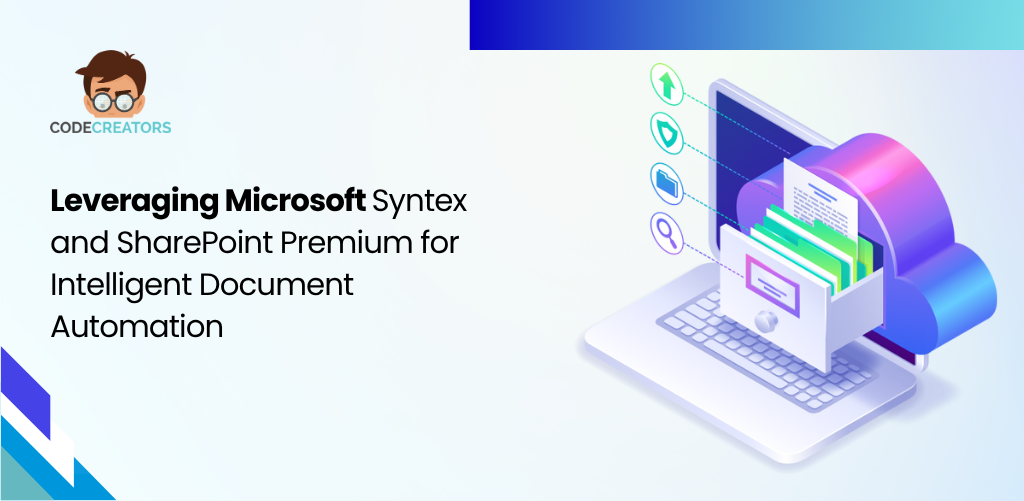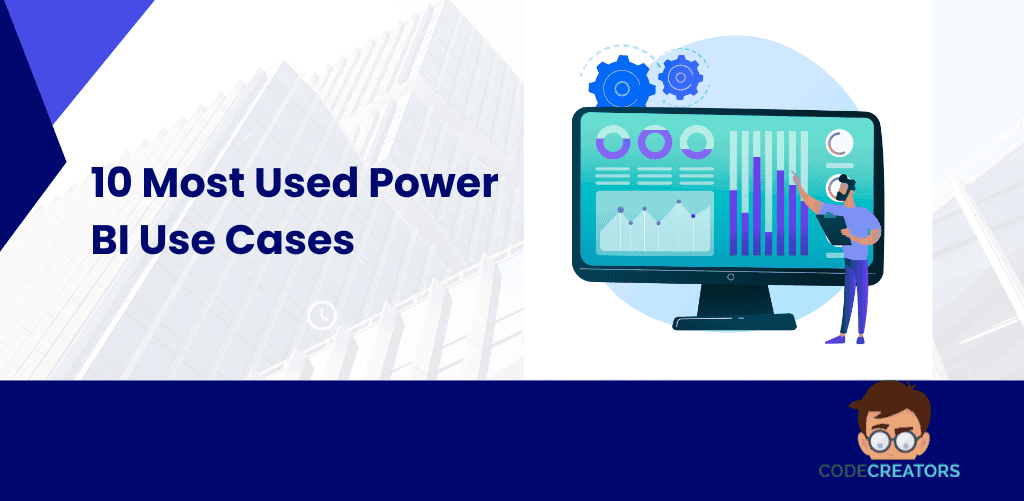Using Microsoft Syntex and SharePoint Premium for Intelligent Document Automation

Are your teams still buried under piles of documents, repetitive tasks, and manual tagging? The solution may be right within your Microsoft 365 environment. With the rise of AI and machine learning, Microsoft has introduced two powerhouse tools – Microsoft Syntex and SharePoint Premium—designed to bring intelligent automation to the document lifecycle.
In this blog, we’ll explore how these platforms work together to revolutionize content processing, streamline compliance, and reduce human error – all while improving employee productivity. We’ll also highlight features like Content AI, structured document processing, and content assembly to show how real-time automation can transform the way your organization handles documents.
What Is Microsoft Syntex?
Microsoft Syntex is an AI-powered content management solution that transforms how organizations classify, tag, and extract information from their documents. Rather than relying on manual document handling, Syntex brings automation through machine teaching models, natural language processing, and AI-driven metadata generation.
Here’s what makes Microsoft Syntex powerful:
- AI-Powered Metadata Extraction: It reads documents and automatically tags them with metadata to improve searchability and classification.
- Document Understanding Models: You can train Syntex to recognize the structure of your business documents—like contracts, invoices, or resumes—without writing any code.
- Integration with Microsoft 365: Syntex lives natively within your SharePoint libraries, meaning no added interface or external software to learn.
- Security and Compliance: All content is processed within your Microsoft 365 tenant, meeting enterprise-grade security and compliance standards.
With Syntex, content becomes more than just data stored in a library—it becomes usable, findable, and actionable across your organization.
Read Also: The Rise of SharePoint Syntex and AI-Powered Content Management
SharePoint Premium Overview
SharePoint Premium is the evolution of SharePoint Syntex, offering extended capabilities for advanced content processing, structured data automation, and intelligent document management. While Microsoft Syntex focuses on AI-powered tagging and understanding, it expands this functionality to include end-to-end automation for structured and unstructured content alike.
Key components of SharePoint Premium include:
- Advanced Document Processing Pipelines: Automate data extraction and classification for structured and semi-structured documents.
- Content Assembly: Generate personalized documents (like contracts or onboarding packs) by combining templates with metadata or dynamic content.
- Pay-As-You-Go Model: Offers flexible consumption-based pricing so you only pay for what you use.
- Enhanced Compliance and Security: Includes encryption, retention policies, and governance controls for sensitive content.
Together, Syntex and SharePoint Premium deliver a powerful platform for content understanding, process automation, and secure document handling at scale.
AI-Powered Content Intelligence (Content AI)
At the heart of both Microsoft Syntex and SharePoint Premium is Content AI—the capability to make sense of documents in a way humans traditionally do, but at machine scale.
Here’s how Content AI helps organizations:
- Auto-Tagging and Classification: Syntex reads files and intelligently tags them with relevant metadata, whether it’s client names, invoice numbers, or contract expiry dates.
- Semantic Understanding: AI models are trained to understand meaning—not just keywords—enabling more accurate search and discovery.
- Content Recommendations: Suggests templates, metadata fields, or next steps based on document type and history.
For example, when uploading a contract, Syntex can automatically identify the contract type, tag it with the appropriate metadata, extract key fields like agreement dates and parties involved, and even suggest renewal reminders.
By leveraging Content AI, businesses reduce reliance on manual input, cut processing times, and eliminate classification errors that can affect compliance and reporting.
Structured Document Processing
One of the standout features of SharePoint Premium is its ability to process structured and semi-structured documents—forms, receipts, invoices, and more—without the need for traditional OCR software or manual entry.
Here’s what it includes:
- Prebuilt Models for Common Documents: Microsoft provides templates to extract fields like purchase order numbers, due dates, or payment terms from invoices and forms.
- Custom Extraction Pipelines: Easily configure new pipelines using SharePoint’s no-code tools to process documents unique to your business.
- Automated Routing: Based on extracted data, documents can be routed to the right teams, folders, or business systems automatically.
Consider an accounts payable department that receives hundreds of invoices weekly. With structured document processing, each invoice can be scanned, parsed, and filed with zero human involvement. Line items can be extracted and pushed into ERP systems, and discrepancies can be flagged immediately for review.
This speeds up business cycles, improves data accuracy, and frees employees to focus on higher-value tasks.
Automated Content Assembly
Creating documents like offer letters, service agreements, or client presentations often involves copying and pasting information from multiple sources. SharePoint Premium changes that with Content Assembly—a feature that automates the generation of rich, personalized documents from templates and metadata.
Here’s how it works:
- Use SharePoint Lists as a Data Source: Populate templates with information stored in your lists (e.g., employee details, project scope, or client data).
- Build Reusable Templates: Create Word-based templates with placeholders for dynamic content.
- Bulk Document Generation: Generate multiple documents at once for scenarios like onboarding, invoicing, or certification.
Imagine HR teams generating hundreds of onboarding documents with customized names, start dates, and roles—all in one click. Legal teams can draft NDAs, contracts, or service agreements dynamically, saving time and minimizing human error.
Content Assembly not only accelerates document creation but also ensures uniformity and compliance with internal standards and legal formats.
Integration with Microsoft 365 Ecosystem
Both Microsoft Syntex and SharePoint Premium are deeply integrated within the Microsoft 365 ecosystem, which means users can benefit from the familiar tools they already use—Outlook, Teams, Word, Excel, and Power Automate.
Examples include:
- Trigger workflows in Power Automate when metadata is updated by Syntex
- Collaborate in Teams with documents automatically routed from SharePoint Premium
- Use Word Online to build templates and preview assembled content
- Apply Microsoft Purview policies for governance and compliance
This native integration ensures that document automation isn’t siloed but rather enhances your existing digital workspace.
Read also: AI-Powered Insights: Unlocking Hidden Potential with Microsoft 365 Copilot
Business Benefits of Intelligent Document Automation
Using Microsoft Syntex and SharePoint Premium offers organizations a compelling set of business advantages:
- Increased Productivity: Reduce manual processing and free employees to focus on strategy and problem-solving.
- Improved Compliance: Automated tagging and data classification improve audit readiness and governance.
- Faster Decision Making: Searchable metadata and structured content make it easier to retrieve and act on information.
- Cost Savings: Lower document processing costs through automation and AI.
- Scalable Solutions: Serve both small teams and large enterprises with pay-as-you-go pricing and flexible deployment.
Whether you’re in legal, HR, finance, or compliance, these tools help digitize operations and unlock data trapped in documents.

Real-World Use Cases
Here are some common ways organizations are using Syntex and SharePoint Premium:
- Legal Departments: Automatically extract case numbers and deadlines from legal documents.
- Human Resources: Assemble personalized offer letters and onboarding documents for new hires.
- Finance Teams: Process and classify invoices and receipts with automated routing and data entry.
- Healthcare Providers: Securely manage and classify medical records with AI tagging and retention policies.
- Education Institutions: Create student information packets using content assembly from SharePoint lists.
These scenarios show just how versatile and impactful intelligent document automation can be across industries.
Final Thoughts
Microsoft Syntex and SharePoint Premium bring together the power of AI, automation, and intelligent document management into a cohesive solution built directly into the Microsoft 365 environment. From understanding unstructured content to processing forms and assembling dynamic documents, these tools redefine what’s possible with your digital content.
As your organization continues to grow, the need for scalable, intelligent content automation becomes more critical than ever. With Syntex and SharePoint Premium, you’re not just storing documents – you’re transforming them into active business assets.
Ready to move from manual document handling to intelligent automation? Start exploring Microsoft Syntex and SharePoint Premium today and unlock a smarter way to manage content.



